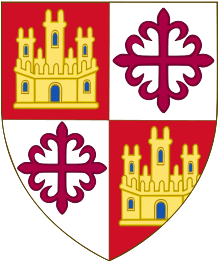Enrique Enríquez the Elder
Enrique Enríquez the Elder (c. 1246 – before 28 February 1323) was a nobleman of Castile, natural son of the Infante Henry of Castile. He was Lord of La Puebla de los Infantes. His son, Enrique Enríquez the Younger, had a distinguished career serving kings Alfonso XI of Castile and Peter of Castile.
Enrique Enríquez the Elder | |
|---|---|
 Coat of arms of the Infante of Castile, Henry the Senator | |
| Born | c. 1246 |
| Died | Before 28 February 1323 |
| Nationality | Spanish |
| Occupation | Nobleman |
Enrique Enríquez was the natural son of the Infante Henry of Castile and Lady Mayor Rodriguez Pecha. His father was son of King Ferdinand III of Castile by his first wife Beatrice of Swabia. His mother was the daughter of Esteban Pérez Pecha, Lord of San Román de Hornija and governor of Zamora, and Mayor Rodriguez de Balboa. Mayor Rodriguez de Balboa was daughter of Pedro Rodríguez de Balboa, chamberlain of the Infante Henry of Castile.
The exact date of birth of Enrique Enríquez is not known. Some authors say he was born in Andalusia around 1246.[1] Others think he was born in Italy during one of the periods when the Infante Henry was staying there.[2] There is some doubt about his paternity, since the Infante Henry did not name him or his mother in his will, despite naming many of his servants.[2] On 27 July 1253 his uncle, Alfonso X of Castile the Wise, gave Enrique Enríquez the lordship of La Puebla de los Infantes, in the present province of Seville.[3]
Enrique Enríquez married Estefanía Rodríguez de Ceballos, Lady of Villalba de los Barros and of Vado de las Estacas. She was daughter of Rodrigo González de Ceballos, Alcalde Mayor of Toledo and Adelantado Mayor of Murcia, and María Fernández de Caviedes, Lady of Caviedes, Lamadrid and La Revilla.[4][5] One son was born of the marriage, Enrique Enríquez the Younger.[6] In 1307 his wife ceded the lordship of Villalba de los Barros to Enrique Enríquez the Younger, with the consent of Enrique Enríquez.[7] The grant was confirmed by a document issued in the city of Valladolid on 12 April 1320 by King Alfonso XI of Castile.[8]
The date when Enrique Enríquez died is unknown, but must have occurred before 28 February 1323. On that date his wife described herself as a widow in a document issued in the city of Seville, when she sold a house.[9] Enrique Enríquez the Younger inherited his parents' possessions and served kings Alfonso XI of Castile and Peter of Castile, who awarded him several grants.[6] Several descendants of Enrique Enríquez, including his son, were buried in the monastery of San Francisco in Seville. The monastery was looted, desecrated and burned by French troops during the Spanish War of Independence and later demolished in the year 1841.[11]
References
Citations
- CASTILE & LEON, COUNTS & KINGS.
- Mata Carriazo y Arroquia 2002, p. 21.
- González 1983, p. 110.
- Ruano & Ribadas 1779, p. 106.
- Trelles Villademoros 1760, pp. 321-322.
- Villar y Macías 1887.
- Mazo Romero 1982, p. 84.
- García Fernández 1988, p. 14.
- Pardo 2003, p. 190.
- González de León 1844, pp. 45-46.
Sources
- "CASTILE & LEON, COUNTS & KINGS". Foundation for Medieval Genealogy. 2000. Retrieved 2013-07-15.
- García Fernández, Manuel (1988). "Regesto documental andaluz de Alfonso XI (1312-1350)". Historia, instituciones, documentos. Sevilla: Universidad de Sevilla: Departamento de Historia Medieval y Ciencias y Técnicas Historiográficas (15): 1–126. ISSN 0210-7716. Retrieved 15 May 2010.CS1 maint: ref=harv (link)
- González, Julio (1983). Reinado y diplomas de Fernando III. Publicaciones del Monte de Piedad y Caja de Ahorros de Córdoba. Retrieved 2013-07-15.CS1 maint: ref=harv (link)
- González de León, Félix (1844). Noticia artística, histórica y curiosa de todos los edificios públicos, sagrados y profanos de esta Muy Noble Ciudad de Sevilla y de muchas casas particulares; con todo lo que les sirve de adorno artístico, antigüedades, inscripciones y curiosidades que contienen. I (1ª ed.). Sevilla: Imprenta de Don José Hidalgo y Compañía.CS1 maint: ref=harv (link)
- Mata Carriazo y Arroquia, Juan de (2002). En la frontera de Granada. Granada: Editorial Universidad de Granada. Campus Universitario de Cartuja. Granada. ISBN 84-338-2842-8.CS1 maint: ref=harv (link)
- Mazo Romero, Fernando (1982). "Propiedad y régimen de explotación en la Tierra de Barros, a fines de la Edad Media". En la España Medieval. Madrid: Universidad Complutense: Departamento de Historia Medieval y Servicio de Publicaciones (3): 81–108. ISSN 0214-3038. Retrieved 15 May 2010.CS1 maint: ref=harv (link)
- Menéndez Pidal de Navascués, Faustino (1982). Instituto Luis de Salazar y Castro (ed.). Heráldica medieval espyearla. Volumen I: La Casa Real de Castilla y León. Hidalguía. ISBN 8400051505.CS1 maint: ref=harv (link)
- Pardo, María Luisa (2003). Documentos y notarios de Sevilla en el siglo XIV (1301-1350).CS1 maint: ref=harv (link)
- Ruano, Francisco; Ribadas, Joannes (1779). Casa de Cabrera en Córdoba. Córdoba: Oficina de Don Juan Rodríguez.CS1 maint: ref=harv (link)
- Trelles Villademoros, José Manuel (1760). Asturias ilustrada: primitivo origen de la nobleza de España. Tomo III. Parte Primera (2ª ed.). Madrid: En la oficina de Domingo Fernández de Arrojo, calle del Carmen. p. 180.CS1 maint: ref=harv (link)
- Villar y Macías, Manuel (1887). Historia de Salamanca ... (Salamanca). Librería Cervantes.